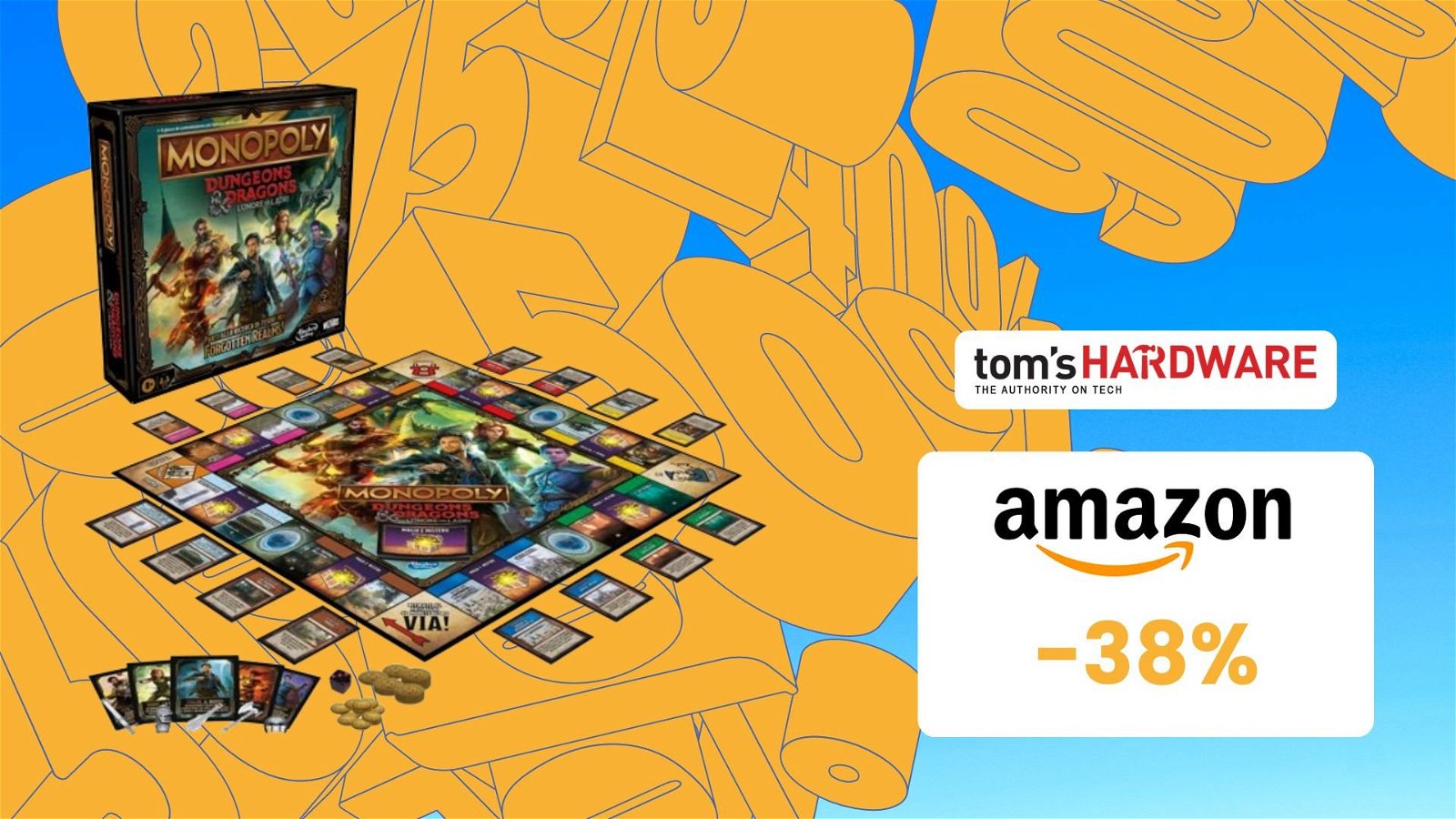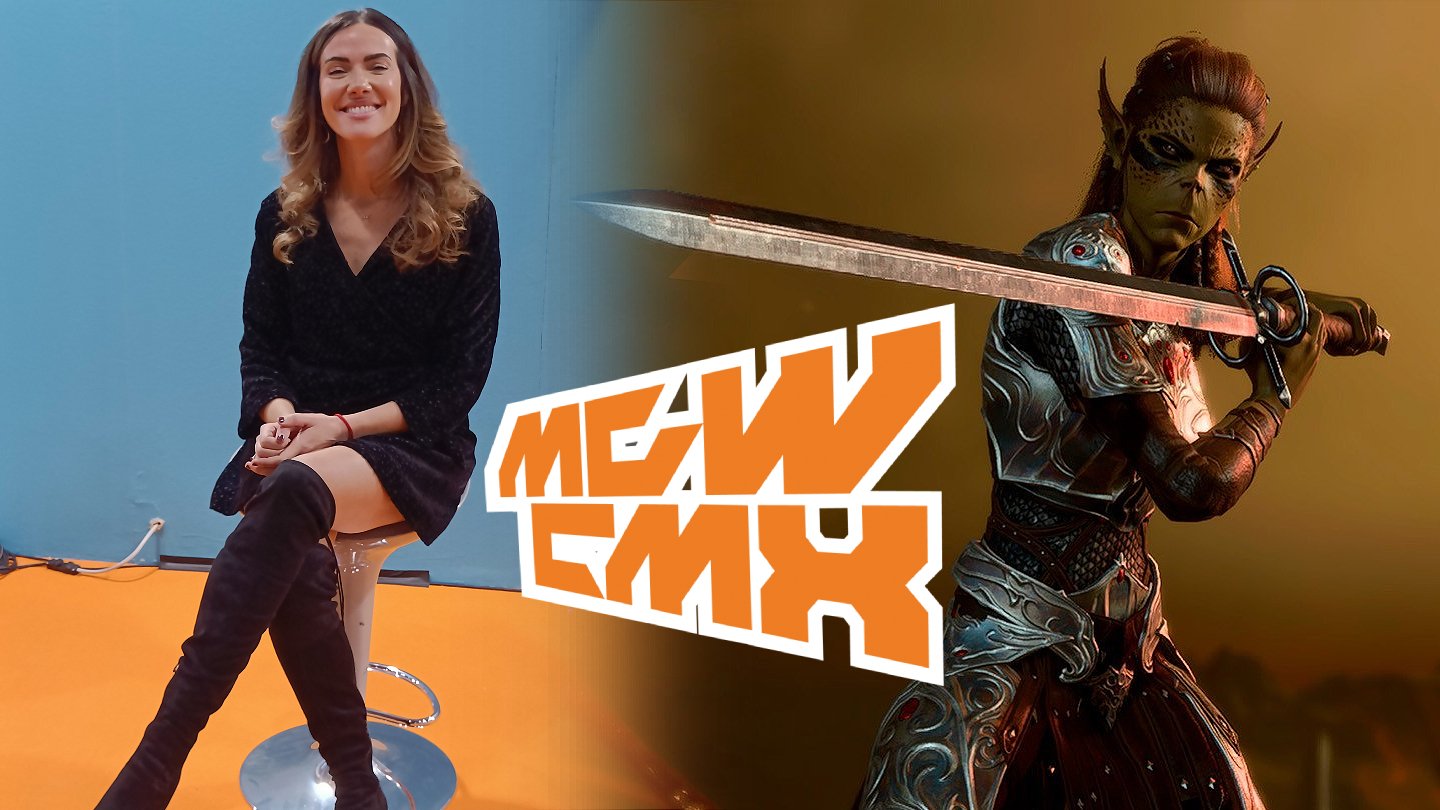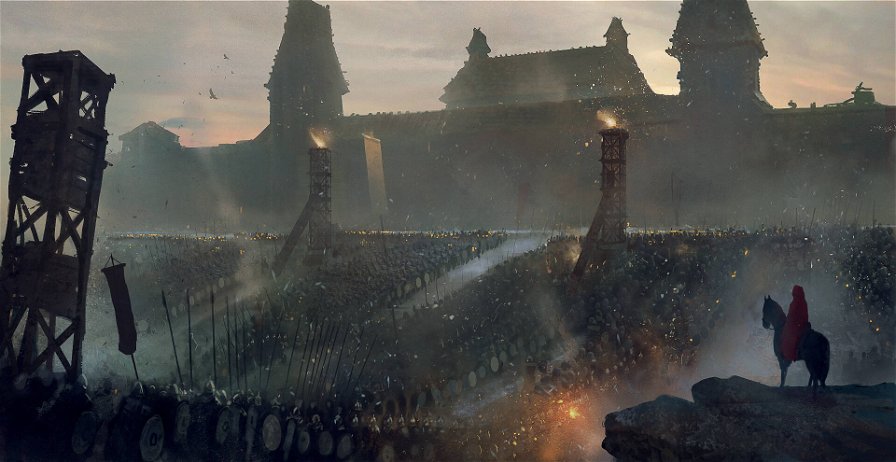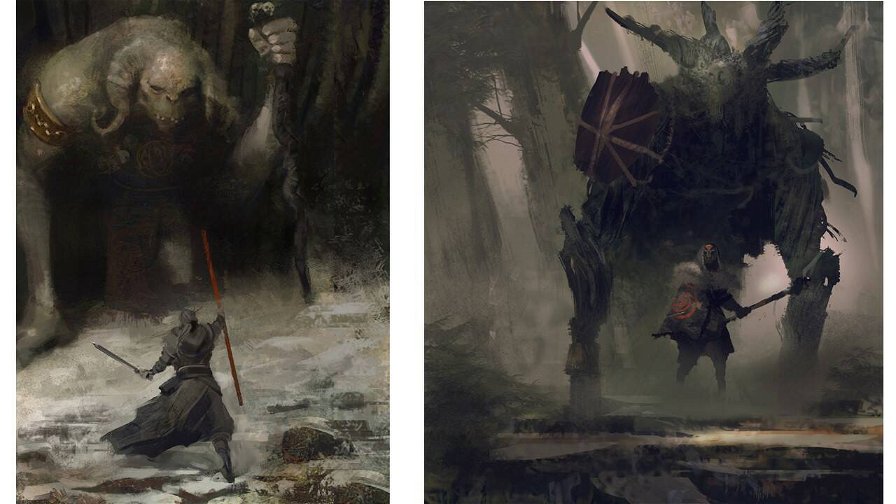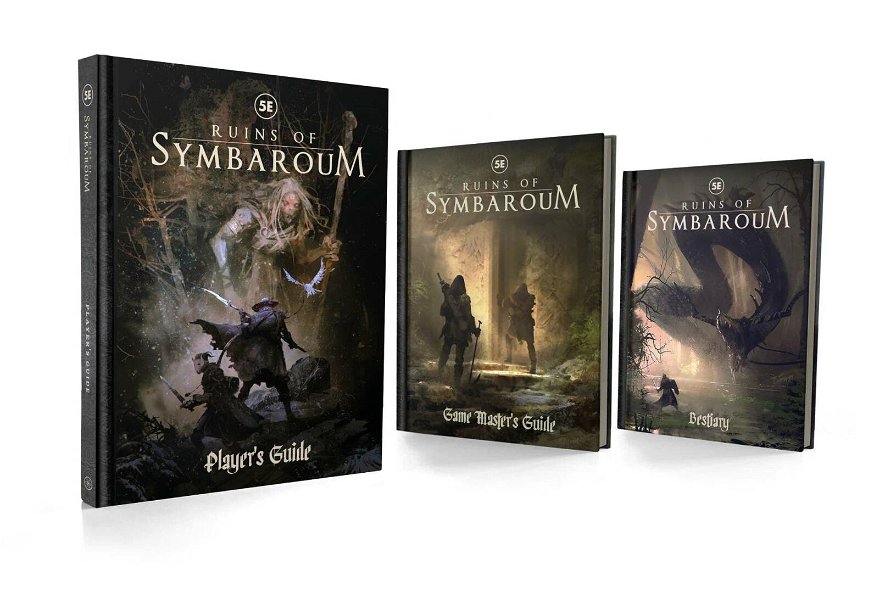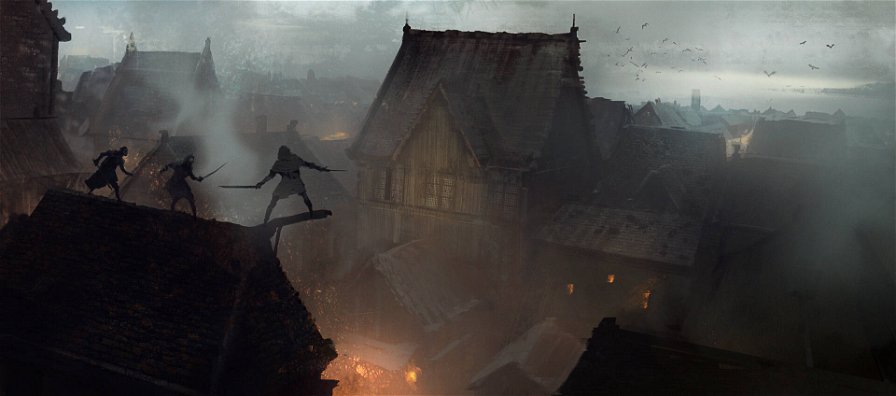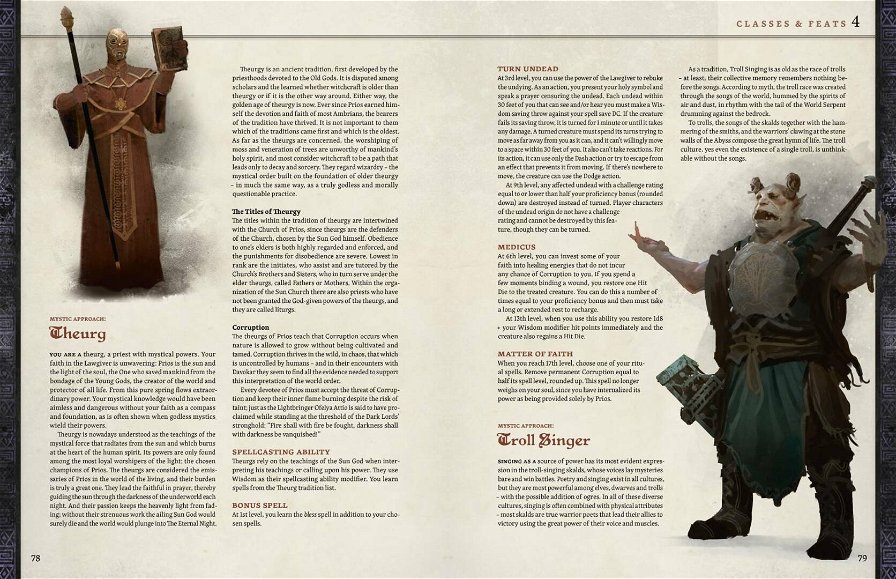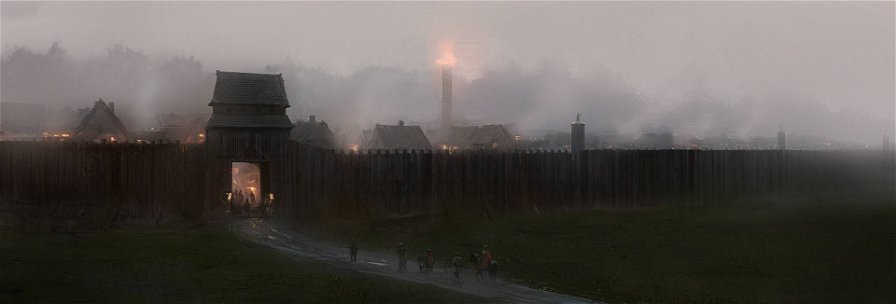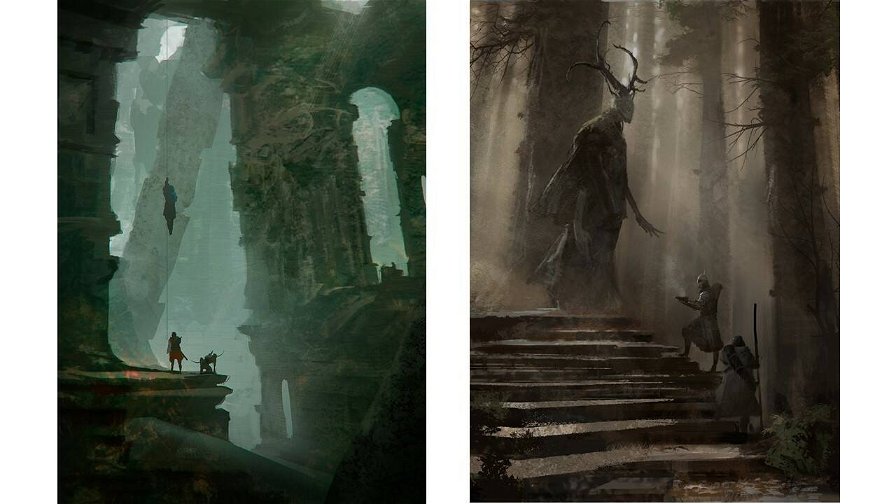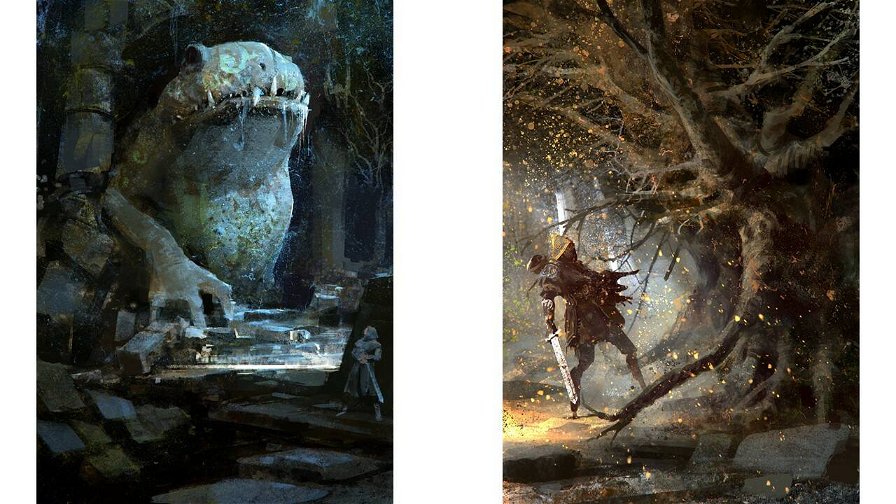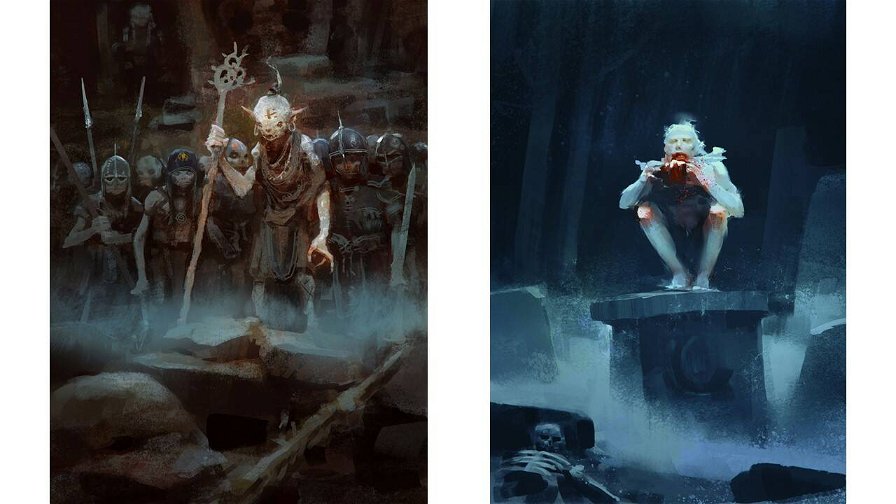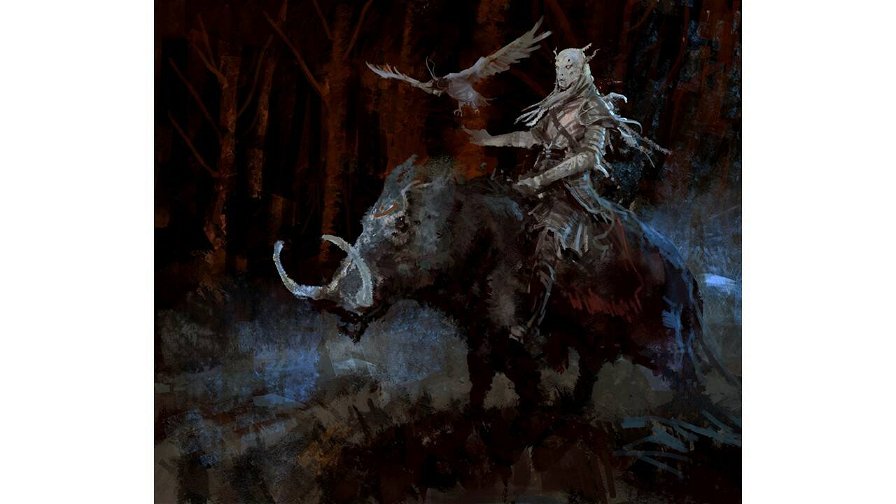In recent days, we had the privilege of being able to connect via Skype with Sweden to interview Mattias Lilja, one of the authors of the tabletop role-playing game Symbaroum from Free League Publishing and Ruins of Symbaroum, the version of Symbaroum for Fifth edition of the most famous fantasy role-playing game in the world, which in these days is making headlines thanks to the Kickstarter campaign that is enjoying great success. In this interview we have dealt with numerous topics, starting from the Symbaroum RPG more generally, to then go on to analyze in depth Ruins of Symbaroum, the real protagonist of this interview. But we also didn't forget to talk about the RPG industry more generally and the role that Dungeons & Dragons plays in this sector. But no more chatter, so let's go to the interview.
Mattias Lilja, author
Hi Mattias, thank you for the time you dedicate to us. We know that in addition to being the author of Ruins of Symbaroum for 5E, you are also the author of the original edition of Symbaroum, that you have had your own game studio and have also worked for the Paradox Interactive software house. Tell us a little about yourself: when did you approach the world of role-playing games? When did you start writing for RPGs and what inspired you to get involved in game creation?I entered the world of role-playing games in the early 1980s. There's a Swedish game called Drakar och Demoner, basically meaning “Dragons and Demons”, it was in 1983. It was based on the Basic Roleplaying System, that you would find in Call of Cthulhu or Runequest, and the same year I got the basicD&D, the red box, which I absolutely loved. So I've been playing D&D since 1983, every edition.
I've been enjoying them differently, but i've never stopped playing it. I played a lot of games but D&D for quite a lot. Since I didn't have any money, I was 12 at the time, I started creating my own content very early just for my own group, together with my friends, and I always had a dream that I would do this professionally.
But I took a long long way there, I didn't start a tabletop RPG company until 2001 (studio Järnringen). So I had other business in between. And that's when we did the game called Mutant: Heirs of Doom, which then Free League picked up and made Mutant: Year Zero. I also wrote a game called Coriolis, which also now is part of the Free League catalog.
At these time, as you said, I was working for Paradox Interactive and I did that for a better part of more than a decade actually, so it was actually just this January, in 2021, that I started making tabletop RPGs full time. So, I waited for a long time to jump on the dream, but it's been with me more or less my entire life. As soon as I could choose myself what I would do, I've been doing playing and creating games.
About Symbaroum
Let's focus for a moment on Symbaroum in general, how did this project come about?
Well, as I said we've done Mutant, which is a post-apocalyptic game, we did Coriolis, which is the sci-fi one, and of course for a long time we talked about if we make or when we make a fantasy game and what should it be. So there's a number of long discussions about it.
It actually has elements of our own a long-standing campaign that we've played ourselves over the years and tried out some ideas. The one of the basic I think tenets of Symbaroom is this nation that is sort of being destroyed by a war that they actually won, so they have to move and the young Queen Korinthia takes her people across the mountains to the north to establish a new realm, and they end up in conflict with barbarians.
That set up actually comes from one of our own campaigns, not exactly like that but quite a lot. So we actually started there, but the rest is something we've purpose built for Symbaroom. We wanted to have this sort of darker or a bit more grim world, when it comes to the aesthetics, but keep the idea of that you explore this forest and ruins, but we wanted to change some of the roles, so you're not necessarily a good guy.
The elves at least see you as a bad guy, that comes poking around in ruins. Maybe it’s a smaller spoiler, but the forest of Davokar was actually planted by the elves, in what's called the Iron Pact, to make sure that everything bad in these ruins stay down, tied down by roots of trees and all that. So, we wanted to make it a fantasy game and twist some a bit more, you know, popular concepts or around. That's how we started building it.
We found the setting of Symbaroum to be truly fascinating, modern and with a strong dark component. Since you are the author and we have the opportunity, we would like to ask you: what is Symbaroum at his roots?
The core of Symbaroum goes back to the idea that mankind is different from nature and that we can choose to live with or against nature, in a sense we can exploit the world like nobody else before us. In this fantasy setting we've given the world a chance to fight back actively, in what we called Corruption inside the realm of Symbaroum, so there's sort of three great forces at play, if you want to talk, i guess, metaphysics.
You have nature that creates, you have humanity that, I would say, disciplines, like you would keep a garden and you can steer it in a certain way, you don't go against it but you decide what lives and grows. But then you can also exploit it, to get the most out of it and if you exploit it, you create corruption; so that's sort of the idea of the world.
There's an anime actually called Princess Mononoke, it has a lot of these themes, it's not like we came up with the themes ourselves, I think they're pretty universal. But we stuck to them and worked how would that work in a world like this, with some humans siding perhaps more with the creativity part, like the barbarians, that in Symbaroum necessarily focused not to create corruption.
They are fine with doing some adaptations of nature that are better for humans but they don't go so far as to, like the old emperor of Symbaroum, who just whatever they want they took. And the using magic is one of the best ways to create Corruption actually in the game, because you warp nature and nature doesn't like it so you get Corruption, that's sort of how the metaphysics of the world is supposed.
About Ruins of Symbaroum 5E
Symbaroum was released in 2014 in Sweden and was released in English in 2016 and has its own game engine and is still in development. What made you want to create Ruins of Symbaroum 5E?
Sure, that's a good question. As i've said, i've played D&D all the iterations before, so as a player and the dm I'm pretty confident, comfortable with the system. There's actually some parallels with D&D, i guess mostly third edition and some fourth edition, that have influenced some mechanics in the original Symbraoum.
And we started talking about making a 5e version of the game quite early, because, well, D&D is the biggest. You can argue if it's the best, but it's the biggest RPG in the world and we knew so most people play it. And we also know that a lot of people that play D&D don't want to add a second rule set, they're not comfortable moving to other games.
So, the question is: can you make a game that keeps the setting, is true to the setting, but still it's Symbaroum but it runs on the 5E engine?. So, we did some tests internally, they ended up becoming like a trial balloon, that we called The Promised Land, that you can get free available online in English and play the early levels.
It's the same introductory adventure that the original Symbaroum game had, we just converted it to see what happens if we play with 5E and it sort of played that well and we got good feedback, some of it positive, some of it more like “okay we need to think some stuff through”. And then we got a hold of Jacob Rogers, who's doing the heavy lifting on the rules side. He's come taking The One Ring game and turn it into the Adventures in Middle Earth, also a 5E adaptation of that game.
We knew we had fans and we wanted to reach them, we thought we had a good opportunity to do it. The downside is that some people, I think, were concerned that we were going to abandon the original game but we're not. This is a parallel track, we're using different people, we're also not making unique content for Ruins of Symbaroum, it's the same content just with a new system. So, ideally for me would be that if Ruins of Symbaroum takes off, we would continue these tracks in parallel. You can get the adventure in one or the other system, it's more up to you how you want to play it. And if we could get to that point, which I hope, then we would be able to do more, because we would have a larger audience, even if it's split between two rule sets. So that's all the why.
The setting of Symbaroum differs greatly from the classic High Fantasy typical of most productions related to 5th Edition. Will there be substantial differences between Ruins of Symbaroum and the "classic" Symbaroum edition?
I think the difference will be between Ruins of Symbaroum and most other 5E products. If you take the original Symbaroom, the concept is that the world is dark and dangerous and you have to explore it. It doesn't really hold your hand that much, you have to go out into the world and you can meet some very dangerous things, so you can't just run, draw your sword and run at whatever moves. We want to keep that when we move to 5E.
Generally, in 5E the game rarely introduces a monster that is too dangerous for you to handle, Symbaroum often does. But that goes back to how we imagine the world, you should often ask yourself: “do we have to fight? Is it important enough to fight? Can we negotiate? Avoid them? Flee? Sneak around? Bribe them?”, whatever. Solve it in a different way, because fighting is dangerous in the original Symbaroum game and we want to keep that in the 5E version as well.
The details of course will be different, especially with the levels in 5E, that introduce a different way of progression rather than the basic original game, but they should play. I say that they are similar in spirit but different in detail. It's not a totally different experience, so they should play pretty similar, even though you have to accept certain difference in detail of course.
If you take the Corruption mechanic, for instance, in a classical 5E game you would have spell slots that you expand the cost spells, in Ruins of Symbaroum you instead get Corruption. And you don't want to go over a certain threshold because then you get physical and mental problems, up to the point that you actually lose your character because they will be consumed by Corruption entirely. So, just like in the base game you can push yourself, and maybe just one more spell because this fight is really hard, so you have that mechanic, you can take a bit of risk using Corruption, and that works the same in the original Symbaroum and in Ruins of Symbaroum 5E. That's exactly the same.
What were the biggest challenges you faced in adapting the Symbaroum setting and rules for 5th Edition?
Very good question. We were lucky, as I said, to have Jacob Rogers on board, that has done this in the past although with The One Ring to Adventures in Middle Earth. I think the introduction of levels for the characters is what sets it the part the most. The Corruption mechanic was pretty straightforward, it works the same way, but making sure that you had twenty interesting levels for a character... The original Symbaroum has a tighter rule set with less options, so having a rich number of options that would be that would feel 5E, but still play like a Symbaroum game, I think was one of the most hardest parts to get.
Then we added a breakthrough. In 5E, not to be too specific, there are two types of rest you can do: a short rest to recuperate some powers, and the long rest. And we added a third which is called extended rest. The extended rest can only be done in a place of great safety, you need, you know, to be inside a building that you can defend or in a village or maybe with the elves, if you manage to get them on your side, or something similar.
Something that's really hard to come by if you're deep in Davokar forest, you're not going to find a lot of safe places. And it's only in those safe places you can do an extended rest which is when you spend hit ties to recover hit points or remove Corruption. So even if you're a powerful group of adventurers you're going to run out of resources, eventually, and you need to rest and you need to find a safe place to do it.
We can't just stop in a dungeon room and rest, to we need to leave and we need to find this place where we're safe. So, that sort of keeps you even though you can do a lot in 5E, you still have to retreat to safety and always look at “are we going to be able to do that or?”. Just keeping the pressure on and make it feel like you're vulnerable even though you're level 16 or whatever. So, I think that was the getting that play to work is what's been the hardest.
Magic in Symbaroum is also treated differently than in 5th Edition; Shadow and Corruption are a completely foreign factor. About Corruption we talked yet, but how did you manage to integrate Shadow?
We kept Shadow and Corruption as is. We still have alignment in 5E because it's seen as core to that system. It's not super interesting necessarily from a Symbaroum standpoint, but you can use it. I mean, Corruption isn't exactly the same as evil, a lot of evil deeds in Symbaroum are done by people who lean heavily into nature or some other of the sort of three forces. It's not like they represent good or evil per se, they're more their physical laws almost more than a moral guideline or anything like that.
Most people in Symbaroum generally see themselves as good and a lot of other people disagree, that's sort of what it's about. So they still exist in terms of how spells work, you can both understand the Shadow, where you can see that somebody is more or less corrupt, but of course we've adapted it to the level system. So, difference between the original Symbaroum and the 5E is that your Corruption threshold goes up as you go up in level, because higher level spells produce more Corruption. So, if you're a high level mystic in Ruins of Symbaroum 5E you can cast a lot of low level spells, no problem, but your top level spells are going to produce a lot of Corruption for you, will be very dangerous.
And of course, like in the original game, if you attune to a magic item you get corruption, if you use powers in a magic item you get corruption, and that goes for everybody. And just like fans of the original game know, there are certain areas in Davokar that is so badly corrupted that it's actually boosting out of the ground, you get corruption just by passing through and so that is the same across the both versions.
Symbaroum's artistic sector is truly remarkable, thanks to the magnificent illustrations by Martin Grip, who oversaw all the products in the editorial line. What can you tell us about the art of Ruins of Symbaroum?
Well, we've tried to be very clear that Ruins of Symbaroum 5E is an adaption of the original game, so we're not producing a lot more content, it's the same texts largely purdue talking about the different groups and the people and the art is also gonna be the same. There might be some extra, depending on if we find that we really need to show something that is not shown in the original books very well, that needs to be shown in 5E, of course we're going to create that. But the ambition is to have literally no new art except new covers and that's because people should be able to not confuse the two lines, but inside the books it's going to be the same.
On the Kickstarter campaign and the future of Ruins of Symbaroum
We saw that the Ruins of Symbaroum Kickstarter campaign was an instant success and virtually all stretch goals are unlocked. Did you expect this success? And what do you think is the reason of such succes?
Well, we hoped for the success, we didn't know, but to be quite honest I think where the Kickstarter stands right now it is what we hoped it would do. As I said, we had people coming to talk to us and say: “you should really make a 5E version of this, I would buy it and I would get my players to play it if it was only 5E, the world is fantastic but my guys don't want to change rules”. So we knew there were a lot of talk like that, we did the trial balloon so we saw that, I think, 6 000 people or some such have downloaded it and we've gotten quite a lot of feedback on it and most of it positive.
So, it's like there's a bunch of guys out there that want to see this happen, but of course you don't know. That's the cool thing about Kickstarter, you have an idea and you launch it and then the fans tell you if you're right or wrong, that's how it works. And so far we seem to be have made a good call and understood what people want. So, I mean, it's still some ways to go and I think it will keep pushing. You often see it's moving along well and usually has a boost at the end, so we'll see where we end up. But regardless, we're happy with how it's done, it's just we deem it a success already, so hopefully we'll get even better.
Given the success achieved, will Ruins of Symbaroum have its own dedicated editorial line, it will continue into something like manuals which include material from the point of view of both rule sets or will the project end with the Kickstarter?
I don't think we will, the ambition is to have separate lines, so you will decide if you buy the 5E book or the original game book. I mean, 5E is still way behind. The whole Throne of Thorns campaign has no 5E conversion yet, but it's given that the Kickstarter is doing well, I hope that we should be able to present that campaign in 5E as well in the future and the dream state for me is that they should be up to the same level. So, whenever we produce a book you can choose the original system or the 5E system, it would be exactly the same product, you just click 5E or: “no I want to stick to the original that's my thing”, so you should be able to get both.
On the RPG industry and the role of D&D in it
Now, let's talk a little more generally about the RPG industry. Most RPG players try to create their own game world at one point or another, often with disappointing results. What advice can you give to those who are about to put themselves in the shoes of the creator of worlds? What elements are essential to make an interesting setting?
Yeah, that's a really good question. I think you need to create a place where you yourself would want to be and explore, as from a sort of player's perspective. It's easy to get caught up in the DM's perspective, or you as a Game Master want to read about the world, there are long pages of history, and Symbaroum has all that, but we've always come back to: “you're a player in this world, what do you do? And what happens when you do it?”.
So, the inside out sort of perspective, I think is very important you don't write unnecessary long essays about the world, that doesn't really impact anyone who plays. So, the player perspective is part of it. But then you can look at it from different angles. There's actually not to promote too much, but in the Game Master's Guide for the original Symbaroum game there is actually a chapter on world building, where we use Symbaroum as an example of how we built the world. Because understanding how we built the world can be how you make it yours. Maybe you don't like what we did exactly, so you want to change some part of it and then, if you understand how we thought about it, you might be able to change it in amaze that doesn't break the world but make it yours.
So, I would go for think about what players do, that's sort of the you always need to do that first and then also come back to that, what do you do in the game, right. But then you can have what themes does the world have. I mentioned the three forces that we talked about, the nature, I guess culture and then corruption, if you want to call them that. Because that's also going to influence how you build the game and what factions you get, what groups are in there, what do they want to do, what do they want to stop…
So, we try to envision the original Symbaroum as a treasure hunt game, where you have to contend with the political factions, I mean the elves and I mean the Queen and her envoys and I mean the Ordo Magica and the Witches from the barbarian side, and of course in the shadows you have all the sorcerers that are allied with corruption or see it as something you should not even try to avoid, maybe you should create lots of it and then use it. So, at heart it's a treasure hunting game to a great extent, which is familiar to most fantasy players, but we've added this layer of metaphysics so you can dig into the world and enjoy it from a different aspect not just the adventure aspect.
D&D 5E certainly has the merit of having started a sort of renaissance of the role-playing market and we can say that even today it is the big fish in the ocean of the RPG, so much so that every year a huge amount of related products come out. In your opinion, over time this could lead to a general flattening of game design and consequently of the market or are they just senseless fears of the detractors of Dungeons & Dragons?
Now, I think they're correct. I think it will happen, but I think it will take longer. Having played RPGs since 1983, we've had booms and busts, if you want to call it that, and sort of plateaus in between, where very little things happen, then some other game comes along. I mean, the classical D&D, the Second Edition D&D and AD&D were in decline when White Wolf and Vampire the Masquerade came, and all that happened in the 90s was like a new way, where focus was not so much on mechanics and dungeons but more on storytelling and identity character, a really clear shift, and then bled together.
Third Edition D&D launched in 2000 and they had learned a lot about the wave that they missed, so it became like a second boom and then it crumbled a bit, Pathfinder came in, did a lot of cool stuff as the Wizards moved into Fourth Edition. I personally liked Fourth Edition, because I like the mix of sort of a board game and role play game, I like that a lot. A lot of people really don't and I understand why, right. So Fifth Edition is back and Fifth Edition in many aspects to me feels more like the stuff I played in the 80s. It's very basic, you can remove almost everything and just have levels, abilities and gear almost.
So, I think these waves are going to come and go and I don't necessarily see it as bad, see it more as a evolutionary process maybe than a revolutionary one. But I understand the fear either, if D&D is so dominant that the business becomes stagnant that'd be bad. I'm going to make a parallel to my be working in the video games industry, which I did for a long time. The cost of making a video game is so high now, usually. You can be an indie and try to do it small, but you almost never get any attention, so you need some funds to get attention. And that's not really true about a pen and paper roleplaying game or a virtual tabletop one.
So, a little group with a cool idea can actually break through and get a fair amount of attention, so I'm less concerned about the tabletop RPG genre because a small group can do it. They don't have to be resource heavy, they can have ideas and passion and change a lot. The video games industry it’s harder now, because of the amount of capital you need to produce something and even the cheap video games aren't that cheap. A bunch of passionate people are going to be hard pressed to do it, they don't have that sort of cash, so even though they're in the games that sometimes pop up.
I think that the tabletop RPG scene is more dynamic because the cost of entry is low so teams can come in and do their thing. And again, with the risk of repeating myself, I think the crowdfunding aspect, Kickstarter or others, we usually use Kickstarter but there are others, they help you seeing what people want. So, you can gauge your risk, you don't have to invest a lot without at least knowing there's something there.
And of course, a lot of people does really high quality RPGs and enhance them out for free, like in the OSR - Old School Renaissance – community, there's a lot of free stuff that's just really good. So, I agree with the detractors in principle, I think they're making too much of it and if 5E should become super dominant and stagnant, somebody else will take over. That would happen, I think it would take some time and it will be feel tiresome, but we've seen it a couple of times where the dominant leader isn't really innovating anymore and then they get overtaken by somebody else who does a lot of cool stuff. So, I'm not super concerned.
In recent years, a lot of successful RPGs have come from Sweden (not that there weren't any before, I still remember when Kult came out). What do you think is the reason for this success?
Well, it's a bit of guesswork, I was young so I don't really know, but Sweden goes back to having a pretty bored middle class in the early 80s, I think, and a lot of kids that didn't really know what to do and we didn't have a lot of money and the computer game industry came late 80s. Very few people in Sweden had a gaming console in the early 80s, there were some Atari and somebody had a Commodore 64 computer late 80s right, but it was not the same thing. So getting a pen and paper role playing game was cheap enough for a lot of people to do it.
And we had some early adopters, as I said. It was this company called Äventyrsspel that went to the US and importance that did the game Drakar och Demoner (Dragons and Demons) in ’83. It was just a bunch of guys, I don't think they were even 20 at that time who launched it. And the second edition of that game, that came in 84, I think sold in 90.000 copies in Sweden and we were maybe six million at the time in the country, so it was a huge saturation among kids ten to fourteen.
And you can even see today among many in the gaming industry and music and movies and all that, they often in interviews make reference to this game as something that they use to fuel their imagination. So, I think we didn't have a lot of options and it came at a perfect time, so a lot of people tried it and it became part of the youth culture that people then carried forward. That's my take on it.
Future projects
Do you have any other projects for Symbaroum and Ruins of Symbaroum in the works? If so, will these products further develop the story and setting?
What we've promised and what we're working on is the next part in the Throne of Thorns campaign which is for original Symbaroum, but I also hope that it will come to Ruins of Symbaroum at some point, it would make sense. When that campaign finishes it's going to be a, I think, a six-part campaign, it's going to be one of the biggest campaigns, if you count pages, that's ever released for any game.
So, we have that and then we don't really know where we're gonna go, we have to talk about and see what fans want. In terms of the world, I don't know if you've seen it, we released a fake spy report that we gave away for free. Iit's basically a spy reporting to Queen Korinthia about the rest of the world, what's happening around Ambria. It's an in-game piece of lore, but it talks about the rest of the world and what happens there.
So going in those directions and making the world bigger is certainly one option, this is still something we discussed, but we have a at least one part left of the campaign we just launched, we have The Haunted Waste, which is part five and then we're gonna have the part six which is the final one. So, a year and a bit more of content production for the current campaign. And during that time, we're going to talk about what to do next. So, I don't really have any anything concrete to say other than that we're talking and we're listening to what people like to see.
Any other projects related to the world of role-playing games?
Sure, I'm involved in Coriolis, so wrapping up the Mercy of the Icons campaign with the third part, coming I hope late this year or at least early next year, and then I'm doing some stuff for Forbidden Lands, of course helping out where we're needed. So, there's a lot of a lot of things to look forward to from Free League where we're going as strong as ever.
Final greetings
What do you want to say to Italian players to convince them to try Symbaroum or Ruins of Symbaroum?
Well, I think there's a lot of. I can't really speak to Italian players in any specific sense, I don't know how they would differ from anyone else, but if you like a dark mythological world that is pretty complex, that doesn't just give cheap answers to tough questions, that pretend that the world is real and it would actually feel kind of real, then I think Symbaroum is for you.
The choice of game system, whether you like the original one or 5E, that's it's just a matter of taste to me. I think this is the world is there regardless, and if you want to understand why the elves are so pissed off at humans, I think you should go into the world and see and make up your own mind what side you want to be on.
Thank you. Now if there is something else that you want to tell us about Symbaroum or Ruins of Symbaroum, otherwise I have no more question for you.
I think you asked a set of really good questions, nothing on the top of my mind that we haven't talked about. I think you caught all the relevant aspects, a few questions that I did not expect, but I really enjoyed them.
Thank you very much! Okay, so thank you Mattias for your time and your kindness. I hope to talk with you again, maybe after Ruins of Symbaroum is out to see how is going on.
Yes for sure! We should talk again soon and make an update and see what happens.

